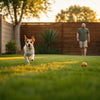How to Cool Down a Dog After Exercise: Essential Tips for Pet Owners
- Houndsy
Table of Contents
- Introduction
- Understanding Heat Stress in Dogs
- Effective Ways to Cool Down Your Dog
- Preventing Heat Stroke
- Conclusion
Introduction
As pet owners, we cherish the moments spent outdoors with our beloved companions, whether it’s a brisk walk in the park or an energetic game of fetch. However, during the sweltering summer months, we must be particularly vigilant about our dogs' well-being, especially when it comes to their ability to cool down after exercise. Did you know that heat stroke can occur in dogs within just minutes of overheating? This alarming statistic highlights the importance of knowing how to cool down a dog after exercise effectively.
In this blog post, we will explore the essential methods for helping our furry friends cool down and prevent heat-related illnesses. We’ll discuss the signs of overheating, effective cooling techniques, and how to create a safe environment for your dog during the hot months. By the end of this article, you’ll have a comprehensive understanding of how to keep your dog safe, happy, and healthy after their exercise routines.
Let’s dive into the ways we can protect our dogs from the heat while still enjoying our outdoor adventures together!
Understanding Heat Stress in Dogs
Before we outline the best practices for cooling down your dog, it's crucial to understand the potential risks associated with heat stress and heat stroke. Dogs do not sweat like humans; instead, they primarily cool down through panting and the evaporation of moisture from their tongues. When the temperature rises, or if they exert themselves excessively, their ability to regulate body temperature diminishes.
Signs of Overheating
Recognizing the signs of overheating is vital for any dog owner. Here are some symptoms that indicate your dog may be struggling to cool down:
- Heavy panting that doesn’t subside
- Excessive drooling
- Weakness or lethargy
- Increased heart rate
- Disorientation or confusion
- Dark red or pale gums
- Staggering or inability to stand
If you notice any of these signs, it’s crucial to act quickly to prevent your dog from progressing to heat stroke, which can be life-threatening.
Effective Ways to Cool Down Your Dog
Now that we understand the risks, let's discuss practical methods for cooling down our dogs after exercise. We at Houndsy are dedicated to enhancing the everyday experience of pet owners, and these tips align with our mission to simplify pet care.
1. Hydration is Key
One of the simplest yet most effective methods for cooling down your dog is ensuring they stay hydrated. Just like us, dogs need access to fresh, cool water after physical activity. Here are some tips:
- Carry a collapsible water bowl during walks or outdoor play. This makes it easy to offer your dog water when needed.
- Encourage slow sips rather than letting your dog gulp down water, as this can cause stomach upset.
2. Escape the Heat
Getting your dog out of the heat is the first step towards cooling them down. Whether you're at home or on the go, here are some strategies:
- Move inside to a cooler area, ideally with air conditioning or a fan.
- Seek shade if you're outdoors. A shaded area can significantly lower the ambient temperature.
3. Use Cooling Mats or Pads
Cooling mats are an excellent investment for pet owners. These mats are designed to absorb and dissipate heat, providing a comfortable resting spot for your dog. Our Houndsy Kibble Dispenser is not just about feeding; it’s about creating an environment where your dog can feel safe and cool, too.
4. Apply Cool, Not Ice-Cold, Water
When cooling your dog, avoid using ice-cold water, as this can lead to vasoconstriction, which traps heat in the body. Instead, use lukewarm water to wet their fur.
- Drape a damp towel over their body, focusing on areas like the neck and groin, where blood vessels are close to the surface.
5. Utilize Fans and Air Conditioning
If you’re indoors, turn on the air conditioning or use fans to create airflow.
- Position a fan so that it blows directly on your dog to help evaporate moisture from their coat.
6. Provide a Shallow Pool
If you have a backyard, consider setting up a small kiddie pool where your dog can splash and cool down. This not only helps them regulate their body temperature but also offers a fun activity!
7. Offer Frozen Treats
Frozen treats can be a delightful way for your dog to cool off.
- DIY frozen dog treats can be made with low-sodium broth, yogurt, and even fruits like blueberries or watermelon (without seeds). Simply freeze them in ice cube trays for a refreshing snack!
8. Mist with Water
Misting your dog with cool water can help lower their body temperature.
- Use a spray bottle to lightly mist their coat, emphasizing the areas with the most fur.
9. Monitor Playtime
While exercise is essential for your dog’s health, it’s equally important to monitor their activity levels during hot weather.
- Schedule playtime for the cooler parts of the day, such as early morning or late evening.
10. Regular Breaks
If you’re hiking or engaging in longer activities, be sure to take regular breaks.
- Pause for water breaks every 15-20 minutes to allow your dog to drink and cool down.
Preventing Heat Stroke
While knowing how to cool down a dog after exercise is crucial, prevention is always better than cure. Here are some proactive measures to reduce the risk of overheating:
- Limit exercise during peak heat hours: Avoid strenuous activities during the hottest parts of the day.
- Know your dog’s breed: Brachycephalic breeds like Bulldogs and Pugs are more prone to overheating due to their short snouts.
- Watch for signs: Always keep an eye on your dog’s behavior and symptoms of heat stress, especially during summer days.
Conclusion
As responsible pet owners, it is our duty to ensure the well-being of our furry friends, especially during hot weather. By understanding how to cool down a dog after exercise and recognizing the signs of heat stress, we can create a safe and enjoyable environment for our pets. Remember, hydration, shade, and cooling techniques are critical in keeping our dogs happy and healthy.
At Houndsy, we believe that a well-cared-for pet is a happy pet. Our commitment to convenience and design excellence extends to every aspect of pet care, including how we manage our dogs’ feeding routines and cooling needs. If you're intrigued by our innovative approach to pet care, consider exploring our Houndsy Kibble Dispenser for a seamless feeding experience that complements your home decor.
FAQ
Q: What are the signs that my dog is overheating?
A: Signs include heavy panting, excessive drooling, weakness, disorientation, and pale or dark red gums.
Q: How often should I offer my dog water during exercise?
A: It’s best to offer water breaks every 15-20 minutes during physical activity, especially on hot days.
Q: Can I use ice-cold water to cool my dog down?
A: No, ice-cold water can cause vasoconstriction. Use lukewarm water instead.
Q: Are certain breeds more susceptible to heat exhaustion?
A: Yes, brachycephalic breeds (e.g., Bulldogs, Pugs) are more prone to overheating due to their anatomy.
Q: What should I do if I think my dog is suffering from heat stroke?
A: Get your dog out of the heat immediately and contact your veterinarian. Time is crucial in these situations.
By staying informed and proactive, we can ensure our dogs enjoy outdoor activities safely and comfortably, making every adventure with them a joyful experience.












